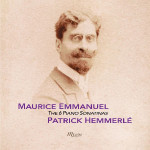|
Back
06/10/2021
“French Musical Rarities: Volume 2”
Maurice Emmanuel: Sonatine n° 1, opus 4, “Bourguignonne” – Sonatine n° 2, opus 5, “Pastorale” – Sonatine n° 3, opus 19 – Sonatine n° 4, opus 20, “en divers modes hindous” – Sonatine n° 5, opus 22, “Alla francese” – Sonatine n° 6, opus 23
Patrick Hemmerlé (piano)
Recording: Eglise Evangélique Saint-Marcel, Paris, France (July 27-29, 2020) – 58’
Melism Records MLS-CD-018 (Distributed by Naxos of America) – Booklet in English and French

   
“It is difficult not to feel a sense of injustice for a composer whose destiny has taken such an unfortunate turn, and one does understand his bitterness, for despite the period of self-doubts, he knew his worth, and was very much wounded by the general neglect of his music.”
Patrick Hemmerlé
Unequivocally, Patrick Hemmerlé makes an immediate, splendid impression! While this young man’s repertoire is firmly entrenched in tradition, he eagerly stretches his limits into the obscure. Having recently released a phenomenal recording of music by Jean Roger-Ducasse, this consummate pianist takes yet another turn down a “road less travelled” by introducing compositions penned by Maurice Emmanuel.
Why haven’t we heard much about Maurice Emmanuel? Much of it had to do with the Frenchman’s penchant for following in the footsteps of his history of music teacher/composer, Louis-Albert Bourgault-Ducoudray, from the Conservatoire. The aforementioned gentleman’s off-kilter and variant designs, at the time, slipped into polyphonies that were found during The Renaissance. Emmanuel’s rooted modal style was met with great resistance, so much so, that he was barred from even competing in the coveted Prix de Rome (by his own composition teacher, Delibes!) This unfortunate circumstance and an overall aversion to his technique prevented Maurice Emmanuel from reaping the benefits so justly deserved, as M. Hemmerlé succinctly summarizes above.
Where does the music rest upon the ear? Perhaps whiffs of Ravellian (“La Caille” or the “Sarabande”) élan or flights of Debussy? Mildly, but Maurice Emmanuel’s music is a separate, magical keepsake.
Glances turn to Fauré’s Dolly Suite (composed in the same year) during the Sonatine n° 1’s opening “Allegro con spirito”, but they quickly fade away. The “Bourguignonne”, Emmanuel’s “most cryptic” of the six Sonatines, paints like brushes of Debussy, and while some movements are more brazen than others, Hemmerlé’s vision of the “Ronde" contrasts the frothy and the weighty bars with great brilliance.
Patrick Hemmerlé’s visit into the Sonatine n° 2’s pastoral outreaches of Emmanuel’s aviary collection is sharply described in illustrious detail. Each of the birds chirps about with colorful differentiation…a veritable delight!
One of the most admirable attributes of M. Hemmerlé’s performance is how engaging and “at ease” he is with this music. Such a case in point can be firmly made during the enigmatic Sonatine n° 3. And while free in form, the piece simply meanders, and appears rudderless, yet the pianist puts to good use his masterful insights into the piece. Patrick Hemmerlé’s handling of the closing “Vivace” is a festival of rambunctiousness and capricious delight. Turning about in folds and caves, this piece is so technically challenging, yet there’s an uncanny freshness about the way the pianist charges through.
Emmanuel’s use of the pentatonic scale is highlighted during the Sonatine n° 4 [“en divers modes hindous”], specifically the “Adagio” which mildly reminisces upon Debussy’s “Et la lune descend sur le temple qui fut” from Images II. But the piece is a startling complexity especially when encountering the frenzied bands during the closing movement.
What could be described as a tableaux of dances, Patrick Hemmerlé’s interpretation of the treasured Sonatine n° 5 retains an open border of courtly and wildly energetic musical footsteps. Maurice Ravel isn’t that far away in certain movements, and the musician’s distinction of dance steps are well-discerned and treated with wide ranges of choreographed distinction.
The closing conversation, Sonatine n° 6, has a very modernistic, jazzy feel to it. The music appears to be way ahead of its time in terms of musical sophistication alongside occasional Gershwin-like edginess.
One of the amazing talents M. Hemmerlé possesses is his ability to pull the left hand notes firmly to the forefront while the right hand yields in cautious obeisance (ref: Sonatine n° 5’s “Gigue” and Sonatine n° 6’s “Presto con fuoco”). Maurice Emmanuel’s music has now been given that extra-special “kick”!
This second volume of “French Musical Rarities” is deserving of four stars. Bravo!
Patrick Hemmerlé Website
Christie Grimstad
|